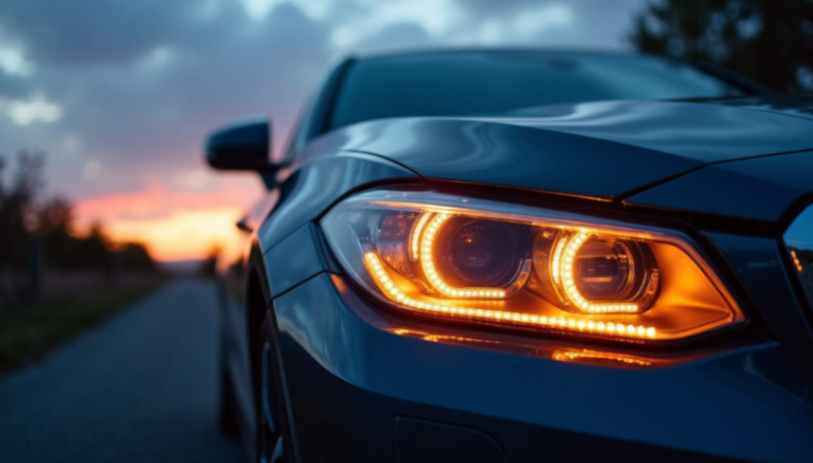Driving at night or in adverse weather conditions presents unique challenges, and the importance of exterior car lights cannot be overstated. These lights not only ensure visibility for the driver but also communicate the vehicle's presence to others on the road. This article explores various facets of exterior car lights, from their role in safety to recent technological advancements.
Understanding the Role of Exterior Car Lights
The exterior lights on a vehicle serve critical functions that extend beyond mere aesthetics. They enhance visibility, improve communication among road users, and promote safety during driving. Understanding these functions helps in grasping their significance in everyday driving.
The Importance of Visibility in Road Safety
Visibility is a cornerstone of road safety. Poor visibility can lead to accidents, as drivers may not see obstacles, other vehicles, or pedestrians in time to react. Exterior car lights ensure that a vehicle is visible to others, thus reducing the likelihood of collisions.
Moreover, increased visibility allows drivers to anticipate potential hazards more effectively. Whether it’s a sharp turn on a lonely road or navigating through thick fog, good lighting enables safer and more confident driving. In fact, studies have shown that vehicles equipped with properly functioning lights are significantly less likely to be involved in nighttime accidents. This highlights the importance of regular maintenance and checks to ensure that all exterior lights are operational and bright enough to serve their purpose.
Different Types of Exterior Car Lights and Their Functions
Exterior car lights come in several types, each serving a unique purpose:
- Headlights: These lights illuminate the road ahead and are essential for nighttime driving.
- Taillights: Located at the rear, they signal to other drivers when a vehicle is braking or slowing down.
- Turn Signals: Indicating a change in direction, these lights play a crucial role in preventing misunderstandings on the road.
- Fog Lights: Specifically designed to cut through fog, rain, or snow, these lights improve visibility in adverse weather conditions.
- Daytime Running Lights: These lights are on when the engine is running, making the vehicle more noticeable during the day.
Each type of light contributes to safer driving by enhancing visibility and communication between drivers. For instance, the use of LED technology in modern headlights not only improves brightness but also increases energy efficiency, reducing the strain on the vehicle's electrical system. Additionally, many new vehicles come equipped with adaptive lighting systems that adjust the direction and intensity of the headlights based on the speed and steering angle of the vehicle, further enhancing safety during nighttime driving.
Furthermore, the design and placement of these lights are subject to regulations that vary by region, ensuring that they meet specific standards for brightness and visibility. This regulatory framework is crucial, as it helps maintain a level of consistency across different vehicle models and manufacturers, which in turn aids drivers in recognizing the signals from other vehicles more intuitively. Understanding these regulations can also empower drivers to make informed decisions when customizing their vehicles, ensuring that any modifications remain compliant with safety standards.
How Exterior Car Lights Contribute to Safety
The proper use and functionality of exterior car lights directly contribute to road safety. Drivers equipped with functional lights are better prepared for various situations that require quick thinking and responsiveness.
Preventing Accidents with Proper Lighting
Properly functioning lights are integral in preventing accidents. When a vehicle is well-lit, it is more visible to others. For instance, having bright headlights allows a driver to see far ahead and react promptly to any hazards.
Accidents often happen because of a failure to see or recognize other vehicles or obstacles. With functioning turn signals, for example, a driver can inform others of their intent to change lanes or make a turn, significantly reducing the risk of a collision.
Moreover, the importance of rear lights cannot be overstated. When a vehicle is stopped on the side of the road or at a traffic signal, having operational brake lights ensures that drivers behind are aware of the vehicle's presence. This simple yet crucial feature can prevent rear-end collisions, which are among the most common types of accidents on the road. Additionally, using hazard lights in emergency situations alerts other drivers to potential dangers, allowing them to navigate around the vehicle safely.
Enhancing Driver Confidence through Improved Visibility
Good lighting not only improves the safety of others but also boosts a driver’s confidence. When drivers believe they can see clearly, they are likely to make better decisions and drive more cautiously.
Furthermore, confidence while driving can alleviate anxiety, particularly for new drivers or those driving in unfamiliar areas. Knowing that their vehicle is equipped with functional lights enhances the overall driving experience, even in challenging conditions.
In addition to the psychological benefits, effective lighting can also enhance a driver's situational awareness. For instance, fog lights are specifically designed to illuminate the road immediately in front of a vehicle in low-visibility conditions, such as fog or heavy rain. This allows drivers to navigate safely through challenging weather without being blinded by standard headlights. The ability to see and be seen clearly fosters a sense of security, encouraging drivers to engage more fully with their surroundings and react to potential dangers more effectively.
Technological Advancements in Exterior Car Lighting
Over the years, advancements in technology have significantly improved exterior car lighting. Driving technology continues to evolve, leading to safer and more efficient lighting systems.
LED Lights and Their Impact on Visibility
Light Emitting Diodes (LEDs) have revolutionized automotive lighting. Compared to traditional bulbs, LEDs are brighter, last longer, and consume less energy. Their brightness provides exceptional visibility for both drivers and pedestrians.
Additionally, LEDs can be designed to produce light in more effective patterns, which can help to illuminate wider areas of the road. This can be particularly beneficial in reducing blind spots during nighttime driving or adverse weather conditions.
Smart Lighting Systems and Safety
Smart lighting systems are another emerging technology in exterior car lights. These systems can adapt the intensity and direction of the light based on various factors, including speed, steering input, and road conditions.
For instance, some systems can automatically adjust headlights to provide better illumination on curves or when transitioning from dark tunnels to bright areas. This adaptability not only enhances visibility but also contributes to the overall safety of the driving experience.
Maintenance Tips for Exterior Car Lights
Maintaining a car’s lighting system ensures optimal performance and safety on the road.
Regular Checks for Optimal Performance
Regularly checking your car’s lights should be a part of routine vehicle maintenance. Drivers should inspect headlights, taillights, and turn signals for any signs of malfunction.
When and How to Replace Your Car Lights
Knowing when to replace your car lights is essential for safety. If you notice a significant drop in brightness or a bulb is completely burnt out, it’s time for a replacement.
Legal Requirements and Standards for Exterior Car Lights
Familiarity with local legal requirements for exterior car lights is essential for all drivers.
Understanding the Legal Aspects of Car Lighting
Different jurisdictions have distinct laws regarding the use and specification of car lights. Understanding these regulations helps ensure compliance and safety on the road.
Meeting Safety Standards with Proper Lighting
Vehicles must meet safety standards that govern the type and function of exterior lighting. Adhering to these standards enhances the vehicle's safety features.
In conclusion, exterior car lights play an indisputable role in enhancing road safety and visibility. With ongoing advancements in technology and a greater emphasis on maintenance and regulations, drivers can ensure a safer driving environment for themselves and others on the road.














